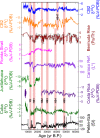Dynamic and thermodynamic influences on precipitation in Northeast Mexico on orbital to millennial timescales
- PMID: 37080955
- PMCID: PMC10119167
- DOI: 10.1038/s41467-023-37700-9
Dynamic and thermodynamic influences on precipitation in Northeast Mexico on orbital to millennial timescales
Abstract
The timing and mechanisms of past hydroclimate change in northeast Mexico are poorly constrained, limiting our ability to evaluate climate model performance. To address this, we present a multiproxy speleothem record of past hydroclimate variability spanning 62.5 to 5.1 ka from Tamaulipas, Mexico. Here we show a strong influence of Atlantic and Pacific sea surface temperatures on orbital and millennial scale precipitation changes in the region. Multiple proxies show no clear response to insolation forcing, but strong evidence for dry conditions during Heinrich Stadials. While these trends are consistent with other records from across Mesoamerica and the Caribbean, the relative importance of thermodynamic and dynamic controls in driving this response is debated. An isotope-enabled climate model shows that cool Atlantic SSTs and stronger easterlies drive a strong inter-basin sea surface temperature gradient and a southward shift in moisture convergence, causing drying in this region.
© 2023. The Author(s).
Conflict of interest statement
The authors declare no competing interests.
Figures





Similar articles
-
Glacial changes in sea level modulated millennial-scale variability of Southeast Asian autumn monsoon rainfall.Proc Natl Acad Sci U S A. 2023 Jul 4;120(27):e2219489120. doi: 10.1073/pnas.2219489120. Epub 2023 Jun 26. Proc Natl Acad Sci U S A. 2023. PMID: 37364110 Free PMC article.
-
Last glacial hydroclimate variability in the Yucatán Peninsula not just driven by ITCZ shifts.Sci Rep. 2023 Sep 1;13(1):14356. doi: 10.1038/s41598-023-40108-6. Sci Rep. 2023. PMID: 37658086 Free PMC article.
-
Pollen from the Deep-Sea: A Breakthrough in the Mystery of the Ice Ages.Front Plant Sci. 2018 Jan 26;9:38. doi: 10.3389/fpls.2018.00038. eCollection 2018. Front Plant Sci. 2018. PMID: 29434616 Free PMC article. Review.
-
Hydroclimate variability in the Caribbean during North Atlantic Heinrich cooling events (H8 and H9).Sci Rep. 2022 Dec 1;12(1):20719. doi: 10.1038/s41598-022-24610-x. Sci Rep. 2022. PMID: 36456594 Free PMC article.
-
A review of hydroclimate variability and changes in the Blue Nile Basin, Ethiopia.Heliyon. 2024 Jan 30;10(3):e25530. doi: 10.1016/j.heliyon.2024.e25530. eCollection 2024 Feb 15. Heliyon. 2024. PMID: 38327459 Free PMC article. Review.
Cited by
-
Atlantic Ocean thermal forcing of Central American rainfall over 140,000 years.Nat Commun. 2024 Dec 4;15(1):10586. doi: 10.1038/s41467-024-54856-0. Nat Commun. 2024. PMID: 39632826 Free PMC article.
-
Local hydroclimate alters interpretation of speleothem δ18O records.Nat Commun. 2024 Oct 21;15(1):9064. doi: 10.1038/s41467-024-53422-y. Nat Commun. 2024. PMID: 39433751 Free PMC article.
References
-
- Knutti R, Sedláček J. Robustness and uncertainties in the new CMIP5 climate model projections. Nat. Clim. Chang. 2013;3:369–373. doi: 10.1038/nclimate1716. - DOI
-
- Lewis, S. C., LeGrande, A. N., Kelley, M. & Schmidt, G. A. Water vapour source impacts on oxygen isotope variability in tropical precipitation during Heinrich events. Clim. Past6, 325–343 (2010).
-
- Liverman DM. Drought impacts in Mexico: climate, agriculture, technology, and land tenure in Sonora and Puebla. Ann. Assoc. Am. Geogr. 1990;80:49–72. doi: 10.1111/j.1467-8306.1990.tb00003.x. - DOI
-
- Johnson, R. Immigration as a response variable to climate change from Mexico into the United States. J. Alt. Perspect. Soc. Sci.3, 758–774 (2011).

